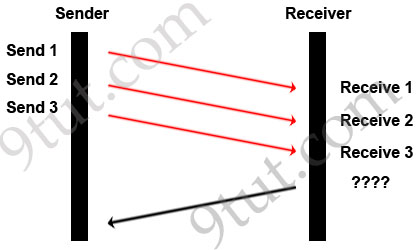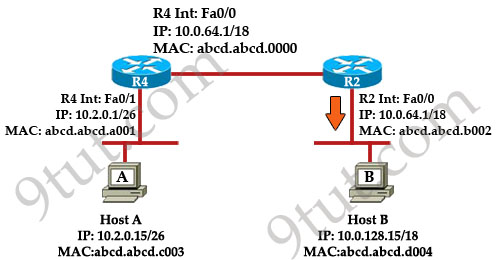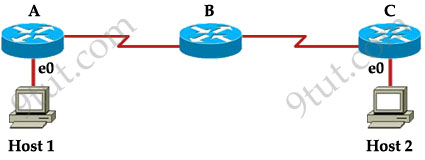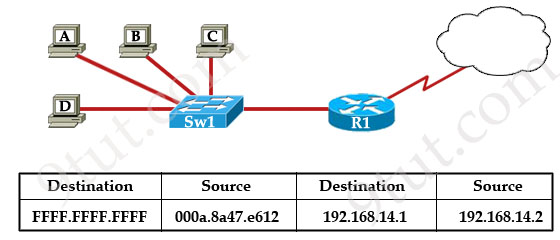CCNA – TCP/IP Model & Operation
Here you will find answers to TCP/IP Model & Operation Questions
Question 1
An inbound access list has been configured on a serial interface to deny packet entry for TCP and UDP ports 21, 23 and 25. What types of packets will be permitted by this ACL? (Choose three)
A. FTP
B. Telnet
C. SMTP
D. DNS
E. HTTP
F. POP3
Answer: D E F
Explanation
The access list denies packet entry for TCP & UDP -> all the services on ports 21, 23 and 25 are disabled. Services on these ports are FTP (port 21), Telnet (port 23), SMTP (port 25). Other services are allowed so D E F are the correct answers.
Question 2
What are two characteristics of Telnet? (Choose two)
A. It sends data in clear text format.
B. It is no longer supported on Cisco network devices.
C. It is more secure than SSH.
D. It requires an enterprise license in order to be implemented.
E. It requires that the destination device be configured to support Telnet connections.
Answer: A E
Explanation
Telnet, part of the TCP/IP protocol suite, is a virtual terminal protocol that allows you to make connections to remote devices, gather information, and run programs. Telnet is considered insecure because it transfers all data in clear text -> A is correct.
The destination device needs to support Telnet connection. For example, if a device doesn’t support TCP/IP protocol suit then maybe we can’t telnet to it.
Question 3
An administrator issues the command ping 127.0.0.1 from the command line prompt on a PC. If a reply is received, what does this confirm?
A. The PC has connectivity with a local host.
B. The PC has connectivity with a Layer 3 device.
C. The PC has a default gateway correctly configured
D. The PC has connectivity up to Layer 5 of the OSI model
E. The PC has the TCP/IP protocol stack correctly installed.
Answer: E
Explanation
The address 127.0.0.1 is called loopback address. When we ping 127.0.0.1, in fact we are testing if the TCP/IP protocol suite is installed on our device.
Note: The address 127.0.0.1 does not have anything related with the NIC card. We still ping 127.0.0.1 even if we don’t have the NIC card.
Question 4
Where does routing occur within the DoD TCP/IP reference model?
A. application
B. internet
C. network
D. transport
Answer: B
Explanation
The picture below shows the comparison between TCP/IP model & OSI model. Notice that the Internet Layer of TCP/IP is equivalent to the Network Layer which is responsible for routing decision.

Question 5
A host is attempting to send data to another host on a different network. What is the first action that the sending host will take?
A. Drop the data.
B. Send the data frames to the default gateway.
C. Create an ARP request to get a MAC address for the receiving host.
D. Send a TCP SYN and wait for the SYN ACK with the IP address of the receiving host.
Answer: B
Explanation
Before sending data, the sending host checks if the destination host is inside or outside the local network. If it is outside the local network, the data will be sent to the default gateway.
Question 6
A TCP/IP Transfer is diagrammed in the exhibit.
A window size of three has been negotiated for this transfer. Which message will be returned from the receiver to the sender as part of this TCP/IP transfer?

A. Send ACK 1-3
B. Send ACK 3
C. Send ACK 4
D. Send ACK 4-6
E. Send ACK 6
F. Send ACK 7
Answer: C
Explanation
In response, the receiver replies with an ACK. The acknowledgment number is set to one more than the received sequence number. The ACK means “I have got all messages up to sequence number n-1 so please send me the message for sequence number n”.
Question 7
What is the purpose using the traceroute command?
A. to map all the devices on a network.
B. to display the current TCP/IP configuration values.
C. to see how a device MAC address is mapped to its IP address.
D. to see the path a packet will take when traveling to a specified destination.
E. to display the MTU values for each router in a specified network path from source to a destination.
Answer: D
Question 8
A network admin wants to know every hop the packets take when he accesses cisco.com. Which command is the most appropriate to use?
A. path cisco.com
B. debugcisco.com
C. trace cisco.com
D. traceroute cisco.com
Answer: D
Question 9
Refer to the exhibit. Host A pings Host B. What source MAC address and source IP address are contained in the frame as the frame leaves R2 destined for host B?

A. abcd.abcd.a001
B. abcd.abcd.b002
C. abcd.abcd.c003
D. 10.2.0.15
E. 10.0.64.1
F. 10.0.128.15
Answer: B D
Explanation
When packets are sent from Host A to Host B, the source and destination IP addresses are never changed and they are the IP addresses of Host A & Host B. Only the MAC addresses will be changed to reflect the device of the current network. In this case, when the frame leaves R2 destined for host B. It will have:
+ Source IP: IP of Host A - 10.2.0.15 (never changed)
+ Destination IP: IP of Host B – 10.0.128.15 (never changed)
+ Source MAC: MAC of Fa0/0 of R2 – abcd.abcd.b002
+ Destination MAC: MAC of Host B – abcd.abcd.d004
Question 10
Host 1 is trying to communicate with Host 2. The e0 interface on Router C is down. Which of the following are true? (Choose two)

A. Router C will use ICMP to inform Host 1 that Host 2 cannot be reached.
B. Router C will use ICMP to inform Router B that Host 2 cannot be reached.
C. Router C will use ICMP to inform Host 1, Router A, and Router B that Host 2 cannot be reached.
D. Router C will send a Destination Unreachable message type.
E. Router C will send a Router Selection message type.
F. Router C will send a Source Quench message type.
Answer: A D
Explanation
The last known good router will try to inform you that the destination cannot be reached (with a Destination Unreachable message type) so from that information you can learn how far your packets can travel to and where the problem is.
Question 11
Refer to the exhibit. The switch in the graphic has a default configuration and the MAC table is fully populated. In addition, this network is operating properly. The graphic represents selected header information in a frame leaving host A. What can be concluded from this information?

A. The MAC address of host A is FFFF.FFFF.FFFF.
B. The router will forward the packet in this frame to the Internet.
C. The switch will only forward this frame to the attached router interface.
D. All devices in this LAN except host A will pass the packet to Layer 3.
Answer: D
Explanation
This frame is leaving host A so host A is the source of this frame. In this frame, the MAC destination is FFFF.FFFF.FFFF which is a broadcast address so Sw1 will flood this frame out all its ports except the port it received the frame -> Hosts B, C, D and the interface connected to Sw1 on R1 will receive this frame. When receiving this frame, they will pass the packet to Layer 3 (because they consider broadcast address “everyone, including me”). At Layer 3, the Destination IP will be checked and only the host (or the interface on the router) with correct IP will respond to Host A while others keep silence -> D is correct.
Just for your information, maybe you can ask “this is a broadcast message so why router R1 doesn’t drop it?”. Suppose this is an ARP Request message. In fact, R1 drops that packet but it also learns that it is an ARP Request so R1 looks up its routing table to find a route to that destination. If it can find one, it will send an ARP Reply back for host A”.



MichaelI have a Billion 7301VGP router with my wileress printer frequently dropping off the LAN. With this model I could step through your solution to fix an IP address for my printer but got stuck at step 9. I don’t have an option Static ARP only Static Route and the step 11 and 12 choices are not listed. Where do I go from here?Thanks
A group of N users located in the same building are all using the same remote
com puter via an ATM network. The average user generates L lines of traffic
(input + out- put) per hour, on the average, with the mean line length being P
bytes, excluding the ATM headers. The packet carrier charges C cents per byte of
user data transported, plus X cents per hour for each ATM virtual circuit open.
Under what conditions is it cost effective to multiplex all N transport
connections onto the same ATM virtual circult, if such multiplexing adds 2 bytes
of data to each packet? Assume that even one ATM virtual circuit has enough
bandwidth for all the users.
Question 10 on CCNA 2nd try today
F*ckin? tremendous isesus here. I am very satisfied to look your article. Thank you a lot and i’m taking a look forward to contact you. Will you kindly drop me a e-mail?
This is just gorgeous. You are the best.
Can someone please email me the latest Dumps to lenoiro27@yahoo.fr?
Thank you
I think the better explanation for Q2 answer E is that the configuration Cisco is talking about is the ‘transport input telnet’ command. If the configuration under the line is ‘transport input ssh’ or ‘transport input none’ then it won’t work. Talking about non TCP/IP stacks is a stretch…
I have a problem with the second paragraph in Q11′s explanation. R1 will not ‘drop’ the ARP request. It will process it and reply if appropriate (like if it is the destination IP). It simply will not forward it out any other links since it is the broadcast domain boundary. The word drop is misleading. Typically the sending device knows – based on its own IP information – if a destination IP is on a different network and forward that packet to the gateway MAC.
what do u think about this question ? This answer is not correct for me
What are two characteristics of SSH? (Choose two.)
A. most common remote-access method
B. unsecured
C. encrypted
D. uses port 22
E. operates at the transport layer
Ansswer : D,E
I need help to open the dump spike or shekter getting only 5 trial copy pls .
Can someone please email me the latest Dumps to alex91401@att.net.
Thanks
please share your latest dumps orthochild@yahoo.com
thanks
@ question
i guess the correct answer to your question is C, D
@Question, examtaker
IMO, correct should be: C,D
Answer in dump just might be wrong.
Q9 WAS ON TODAY’S EXAM
Can someone please email me the latest Dumps to cristian.romedea@gmail.com
hey guys .. i don’t understand the question 5
Question 5
A host is attempting to send data to another host on a different network. What is the first action that the sending host will take?
i think that at first the encapsulation process takes place before sending the frames to the default gateway .. waiting for your replies guys
q10 in today exam
to sit this june
Mina Rizkalla, on question 5.
What happens is this, host creates an ARP, when it get to the router, the routers says “I have a route to this Remote host, here, use my MAC to reach it”, so it sends frames to the default gateway, to then be redirected to corresponding host.
can someone e-mail me the latest sumps tnamik79@gmail.com
can someone e-mail me the latest dumps tnamik79@gmail.com please
Pliz i will sit for the exam next month, can someone send me the latest dumps on email: olesimbe@yahoo.com?
Pliz i will sit for the exam next month, can someone send me the latest dumps on email: olesimbe@yahoo.com
can somebody pliz send me the latest dumb please…ma Email ricksolon@yahoo.com.
Thanks in advance
@question @examtaker @blacky
All 3 are correct SSH does operate at a transport layer, it uses port 22 and is encrypted, all 3 options should be correct
It uses port port 22: http://www.iana.org/assignments/service-names-port-numbers/service-names-port-numbers.xml
If it uses port 22 according to the IANA it operates on both TCP and UDP which are transport layer protocols
I’ve spent a lot of time in research on cisco.com wikipedia, cisco books, but i couldn’t find clear information on how to discard one another
I read somewhere that SSH operates at an application layer as well… that i’m not 100 sure…
Awsome question Very helpful
@Question, @Examtaker, @Blacky: C, D are correct
@Luisk: if you recall it correctly TCP and upper layers don’t use hardware (MAC Address) and logical address (IP Address) to understand the sending host’s address as the data link and network layer protocols do, instead, they use port numbers, what if the question was about http and port 80 being a choice, i’m pretty sure you’d have picked it as operating at transport layer, no my friend, transport is just a layer it goes through to get processed until reaches the right end
passed ccna today
all questions here valid
sims were eigrp, ACLs.
Thank you 9tut you re the best
tomorrow is my day of exam :)
Hello everyone, i’m new to Cisco CCNA and i’ll be taking my first try of the certification exam on September, 2013. Can anyone please send me the latest CCNA dump? i really need it together with my review in 9tut. My e-mail address is rfbt_25080983@yahoo.com. I would really appreciate it if anyone of you would kindly do so. Thank you and God bless.
i need latest dump for CCNA 640-802 can someone mail me at
Thanks in Advance
Please send me the latest dump to
El_lago_de_snake@hotmail.com
Thank you
can someone send me last dumps please ! to jahon83@gmail.com
الحمدلله
PASSED TODAY WITH 973
THANK U 9TUT AND EXAMCOLLECTION
EIGRP(AS wrong in the new router and wrong&missing network address in main router ) ,VTP, Access list2 (host B )simulation
9tut, Spike VCE and shekhar .are valid 100%
short command ” tab ” key are valid in exams
no previous command just next
God bless you everyone
Congrats hiba….
i want to ask some question :
1- is the ccna 640-802 will not be different than question in 9tut (same method) ?
2- i am afraid from lab questions ?
3- is some one have a voucher for me i am from egypt
can someone send me last dumps please ! to -> beshoy.mekhail@gmail.com
ALHUMDOLILLAH
Thanks GOD I pass today. I recommend spike dump, 9tut, and for Urdu students urduitacademy.com. All questions came from spike dump and labs from 9tut. Thanks spike, 9tut and Mr. Kashif from urduitacademy…any query —> ks_jafry@yahoo.com
Hi Guys,
Please email me the latest dumps johnlee4022@yahoo.com.sg, thanks.
Can someone please send me the latest CCNA dumps to kimms12@gmail.com?
Thank you in advance
Hie guys this will be the 2nd time I take ccna exam the first time I failed with 749 because I was slow and I panicked. I’m taking it again in two weeks can someone pliz pliz help me with latest dumps to my email: munogava7@gmail.com. Any help will be greatly appreciated. Thank u!
aslam o alakum , main september 2013 main ccna ka imtihan de reha hoon aap sub se guzarish hay mug ko latest dum e mail ker dain
bohat meher bani ho gi
jazak allah; husein005@hotmail.com
q10, was in my exam
Q5, i think the answer is C, because the first action is ARP to get the default gateway MAC address.
Hi Guys,
Please email me the latest dumps to supportpc84@hotmail.com
Thanks,
Mike
I passed ccna in 2010 and not work in field..lf any body help me l thankfull
Please please please guys i am preparing for the exam next week, can someone be kind enough to send me the latest dumps on my e-mail : armand33m@yahoo.fr
can someone email me the lastest dumps to wkenawiy@yahoo.com please
can you send me latest dump of ccna 640-802 to rahulprasad824@gmail.com ..
Can someone email me the lastest dumps to yaver.mammadov@gmail.com ?
Thanks advance :)